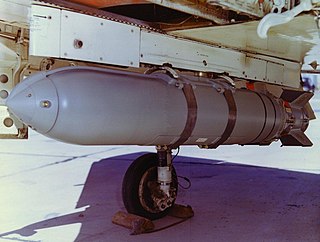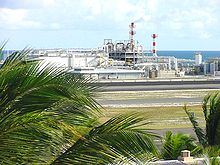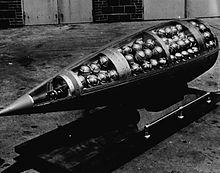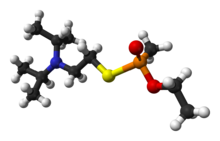
Chemical warfare (CW) involves using the toxic properties of chemical substances as weapons. This type of warfare is distinct from nuclear warfare, biological warfare and radiological warfare, which together make up CBRN, the military acronym for chemical, biological, radiological, and nuclear, all of which are considered "weapons of mass destruction" (WMDs), a term that contrasts with conventional weapons.
3-Quinuclidinyl benzilate (QNB) is an odorless and bitter-tasting military incapacitating agent. BZ is an antagonist of muscarinic acetylcholine receptors whose structure is the ester of benzilic acid with an alcohol derived from quinuclidine.

The United States is known to have possessed three types of weapons of mass destruction: nuclear, chemical, and biological weapons. The U.S. is the only country to have used nuclear weapons on another country, when it detonated two atomic bombs over two Japanese cities of Hiroshima and Nagasaki during World War II. It had secretly developed the earliest form of the atomic weapon during the 1940s under the title "Manhattan Project". The United States pioneered the development of both the nuclear fission and hydrogen bombs. It was the world's first and only nuclear power for four years, from 1945 until 1949, when the Soviet Union produced its own nuclear weapon. The United States has the second-largest number of nuclear weapons in the world, after the Russian Federation.

The M687 was an American 155 mm binary sarin chemical artillery shell. The design was standardized in 1976 and production began on December 16, 1987 at Pine Bluff Arsenal, Pine Bluff, Arkansas. Production was halted three years later, following the 1990 Chemical Weapons Accord between the United States and the USSR, and the dismantling of existing stocks began in November 1997 at Hawthorne Army Depot, Nevada. America's remaining stocks were stored at the Deseret Chemical Depot, Utah, and the Umatilla Chemical Depot.

The Tooele Chemical Agent Disposal Facility or TOCDF, is a U.S. Army facility located at Deseret Chemical Depot in Tooele County, Utah that was used for dismantling chemical weapons.

The United States Army Chemical Materials Activity (CMA) is a separate reporting activity of the United States Army Materiel Command (AMC). Its role is to enhance national security by securely storing the remaining U.S. chemical warfare materiel stockpiles, while protecting the work force, the public and the environment to the maximum extent.

The Pueblo Chemical Depot is a chemical weapons storage site located in Pueblo County, Colorado, United States. The Pueblo Chemical Depot was one of the last two sites in the United States with chemical munitions and chemical materiel. The Pueblo Chemical Agent Destruction Pilot Plant (PCAPP) which is under the Program Executive Office, Assembled Chemical Weapons Alternatives program destroyed its stockpile of 155mm and 105mm artillery shells and 4.2-inch mortars, all of which contained a form of the chemical agent mustard gas.
Blue Grass Army Depot (BGAD) is a U.S. Army Joint Munitions Command storage facility for conventional munitions and chemical weapons. The facility is located in east central Kentucky, southeast of the cities of Lexington and Richmond, Kentucky. The 14,494-acre (58.66 km2) site, composed mainly of open fields and wooded areas, is used for munitions storage, repair of general supplies, and the disposal of munitions. The installation is used for the storage of conventional explosive munitions as well as assembled chemical weapons. The depot primarily is involved in industrial and related activities associated with the storage and maintenance of conventional and chemical munitions.

The M33 cluster bomb, also known as the (M33) Brucella cluster bomb, was a U.S. biological cluster bomb developed in the early 1950s and deployed in 1952. It was the first standardized biological weapon in the U.S. arsenal.

The Deseret Test Center was a U.S. Army operated command in charge for testing chemical and biological weapons during the 1960s. The Deseret was headquartered at Fort Douglas, Utah, a former U.S. Army base.

The M43 BZ cluster bomb, or simply M43 cluster bomb, was a U.S. chemical cluster bomb intended to deliver the incapacitating agent known as BZ. The weapon was produced in the early 1960s and all stocks of U.S. BZ were destroyed by 1989.
The M138 bomblet was a sub-munition of the U.S. chemical weapon, the M43 BZ cluster bomb. The bomblet contained BZ, an incapacitating agent and was developed with the M43 in 1962. The M138s, along with all other U.S. BZ weapons were destroyed during the 1980s.

The M44 generator cluster was an American chemical cluster bomb designed to deliver the incapacitating agent BZ. It was first mass-produced in 1962 and all stocks of the weapons were destroyed by 1989.

The Weteye bomb was a U.S. chemical weapon designed for the U.S. Navy and meant to deliver the nerve agent sarin. The Weteye held 160 kg (350 lb) of liquid sarin and was officially known as the Mk 116. Stockpiles of Weteyes were transferred to Utah in the 1980s amidst controversy and protest.
The E14 munition was a cardboard sub-munition developed by the United States biological weapons program as an anti-crop weapon. In a series of field tests in 1955, the E14 was loaded with fleas and air-dropped.

The Program Executive Office, Assembled Chemical Weapons Alternatives is responsible for the safe and environmentally sound destruction of chemical weapons stockpiles previously stored at the Blue Grass Army Depot, Kentucky, and the U.S. Army Pueblo Chemical Depot, Colorado. In 1996, the United States Congress established the ACWA program to test and demonstrate alternative technologies to baseline incineration for the destruction of chemical weapons. The ACWA program oversaw the design and construction of the two chemical weapons destruction pilot plants – the Pueblo Chemical Agent-Destruction Pilot Plant (PCAPP) in Colorado and the Blue Grass Chemical Agent-Destruction Pilot Plant (BGCAPP) in Kentucky. As of July 7, 2023, PCAPP and BGCAPP have both concluded destruction of their respective stockpiles of chemical weapons. PEO ACWA will continue to oversee both plants through their closure phases, each estimated to take three to four years.

The Pueblo Chemical Agent-Destruction Pilot Plant (PCAPP) is a chemical weapons destruction facility built to destroy the chemical weapons stockpile formerly stored at the U.S. Army Pueblo Chemical Depot (PCD) in southeastern Colorado. The stockpile originally contained 2,613 U.S. tons of mustard agent in 155mm projectiles, 105mm projectiles and 4.2-inch mortar rounds. The weapons had been stored at the 23,000-acre depot since the 1950s.
The United States chemical weapons program began in 1917 during World War I with the creation of the U.S. Army's Gas Service Section and ended 73 years later in 1990 with the country's practical adoption of the Chemical Weapons Convention. Destruction of stockpiled chemical weapons began in 1986 and was completed on July 7, 2023. The U.S. Army Medical Research Institute of Chemical Defense (USAMRICD), at Aberdeen Proving Ground, Maryland, continues to operate.
















